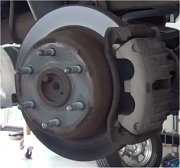Hi,
Replacing rear brake pads and rotors really isn't too hard. If you do it yourself, make sure to get lifetime parts so you won't have to pay for them again in the future. Also, you can expect rear brake pads to last approximately 30,000 miles. However, that varies based on driving habits and terrain. Check out the diagrams (Below).
To start, here is a link that shows in general how it is done. You can use this as a guide.
https://www.2carpros.com/articles/how-to-replace-rear-brake-pads-and-rotors
Next, here is a video showing it being done on a Subaru Legacy. Although it is a different vehicle, the procedure is similar.
https://youtu.be/-6lQSA-Em0Y
Here are the directions specific to your vehicle for replacement. The pics below correlate with the directions.
Removal and Installation
NOTICE: Do not spill brake fluid on painted or plastic surfaces or damage to the surface may occur. If brake fluid is spilled onto a painted or plastic surface, immediately wash the surface with water.
NOTE: Removal steps in this procedure may contain installation details.
WARNING: Service actions on vehicles equipped with electronic parking brakes may cause unexpected parking brake application, which could result in injury to hands or fingers. Put the electronic parking brake system into service mode prior to servicing or removing rear brake components. Failure to follow this instruction may result in serious personal injury.
Activate the EPB service mode.
Refer to: Electronic Parking Brake (EPB) Service Mode Activation and Deactivation (206-05 Parking Brake and Actuation, General Procedures) .
Remove the wheel and tire.
Refer to: Wheel and Tire (204-04A) .
Remove the brake caliper spring.
NOTICE: Do not pry in the caliper sight hole to retract the pistons as this can damage the pistons and boots.
NOTICE: Do not allow the brake caliper and anchor plate assembly to hang from the brake hose or damage to the hose can occur.
NOTICE: If the inboard brake pad is equipped with a center pin, align the center pin of the brake pad with the brake caliper piston pocket or damage to the brake pad or caliper piston may occur. If necessary, rotate the piston counter clockwise to align with the pin.
Remove the caps, the guide pins and position the brake caliper aside.
Torque : 21 lb.ft (28 Nm)
Remove the brake pads.
NOTICE: Use care when pushing the caliper piston into the caliper piston bores or damage to components may occur.
Compress the brake caliper piston until the piston bottoms out in the brake caliper bore.
NOTICE: Do not apply over 20 Nm (177 in-lb) force when rotating the brake caliper piston or internal damage to the brake caliper may occur.
If the brake caliper piston bottoms out and the piston is still not fully compressed, rotate the piston clockwise while pushing inward using a brake caliper piston retractor until the piston is fully compressed.
Use the General Equipment: Brake Caliper Piston Retractor
Installation
NOTICE: Make sure that the brake hose is not twisted when installing the brake caliper or damage to the brake flexible hose may occur.
NOTE: Make sure the inboard brake pad anti-rattle spring is present or a rattle noise may occur.
To install, reverse the removal procedure.
Deactivate the EPB service mode.
Refer to: Electronic Parking Brake (EPB) Service Mode Activation and Deactivation (206-05 Parking Brake and Actuation, General Procedures) .
Depress the brake pedal several times, check the brake fluid level in the brake fluid reservoir and add the specified brake fluid as necessary.
Material : Motorcraft DOT 4 LV High Performance Motor Vehicle Brake Fluid / PM-20 (WSS-M6C65-A2)
Check out the diagrams (Below). Let us know what happens and please upload pictures or videos of the problem.
Images (Click to make bigger)
Thursday, March 11th, 2021 AT 8:45 PM


























